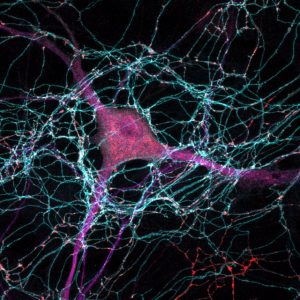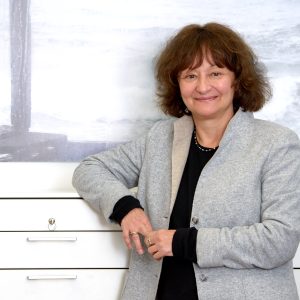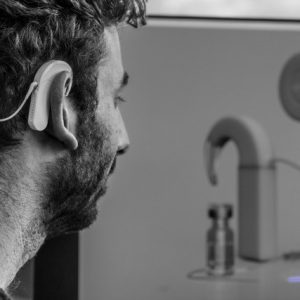31.05.2022
Authors Elizarova S, Chouaib A, Shaib A, Hill B, Mann F, Brose N, Kruss S, Daniel JA Journal PNAS Citation Proc Natl Acad Sci U S A. 2022 May 31;119(22):e2202842119. Abstract The neurotransmitter dopamine controls normal behavior and dopaminergic dysfunction is prevalent in multiple brain diseases. To reach a detailed
31.05.2022
Tiago Outeiro und Annekatrin König erhalten Innovationspreis der Parkinson-Stiftung
Die „Parkinson-Stiftung“ zeichnet Wissenschaftler*innen der Universitätsmedizin Göttingen für ihren Projektvorschlag „Glykierung von alpha-Synuclein als Biomarker“ mit dem Innovations-Preis in der Kategorie „Grundlagenforschung“ aus. Innovations-Preis ist mit 100.000 Euro dotiert. Dr. Annekatrin König, wissenschaftliche Mitarbeiterin, und Prof. Dr. Tiago Fleming Outeiro, MBExC-Mitglied und Direktor der Abteilung für Experimentelle Neurodegeneration der Universitätsmedizin
27.05.2022
Oct4 differentially regulates chromatin opening and enhancer transcription in pluripotent stem cells
Authors Xiong L, Tolen EA, Choi J, Velychko S, Caizzi L, Velychko T, Adachi K, MacCarthy CM, Lidschreiber M, Cramer P, Schoeler HR Journal eLife Citation eLife 11:e71533. Abstract The transcription factor Oct4 is essential for the maintenance and induction of stem cell pluripotency, but its functional roles are not
27.05.2022
Dopamin-Nanosensoren messen Signalübertragung zwischen Nervenzellen
Göttinger Forschenden ist es gelungen, die Freisetzung des Botenstoffs Dopamin aus Nervenzellen mit bislang unerreichter Genauigkeit zu messen. Dies ermöglicht, die Mechanismen der Dopamin-Signalübertragung detaillierter zu untersuchen und so aufzuklären, wie damit zusammehängende Krankheiten entstehen. Link zur MPI-NAT Pressemitteilung
27.05.2022
Remote control of the heart and beyond
Authors Zimmermann WH Journal Science Citation Science. 2022 May 27;376(6596):917-918. Abstract A resorbable closed-loop sensor-actuator implant can temporarily control heart rate. DOI 10.1126/science.abq0605 Pubmed Link
26.05.2022
Excited state lifetime modulation in semiconductor nanocrystals for super-resolution imaging
Authors Ghosh S, Hollingsworth JA, Gallea JI, Majumder S, Enderlein J, Chizhik AI Journal Nanotechnology Citation Nanotechnology. 2022 Jun 15;33(36). Abstract We report on proof of principle measurements of a concept for a super-resolution imaging method that is based on excitation field density-dependent lifetime modulation of semiconductor nanocrystals. The prerequisite
25.05.2022
Electrically Controlling and Optically Observing the Membrane Potential of Supported Lipid Bilayers
Authors Yudovich S, Marzouqe A, Kantorovitsch J, Teblum E, Chen T, Enderlein J, Miller EW, Weiss S Journal Biophysical Journal Citation Biophys J. 2022 May 25:S0006-3495(22)00430-1 Abstract Supported lipid bilayers are a well-developed model system for the study of membranes and their associated proteins, such as membrane channels, enzymes, and
24.05.2022
Noonan-Syndrom: DFG fördert Erforschung neuer Behandlungsmöglichkeiten
Die Deutsche Forschungsgemeinschaft (DFG) fördert die Erforschung von personalisierten Behandlungsmöglichkeiten des Noonan-Syndroms in der Stem Cell Unit der Universitätsmedizin Göttingen (UMG) mit 467.580 Euro. Das Team unter der Leitung von MBExC Mitglied Dr. Lukas Cyganek erforscht die „Identifizierung personalisierter Behandlungsmöglichkeiten für das Noonan-Syndrom mittels Genotyp-Phänotyp-Korrelation in patientenspezifischen iPSCs“ für drei
24.05.2022
Marina Rodnina in die National Academy of Sciences gewählt
Die US-amerikanische Wissenschaftsakademie ehrt die Direktorin am Max-Planck-Institut (MPI) für Multidisziplinäre Naturwissenschaften und das MBExC-Mitglied mit der Aufnahme als Auswärtiges Mitglied für ihre innovative Forschung zur Struktur und Funktion von Ribosomen – den Proteinfabriken der Zellen. Link zum Pressebericht des MPI-NAT
20.05.2022
Neuartige molekulare Prothese für das Gehör
Weltweit esrtmals: Forschenden der Universitätsmedizin Göttingen und des Institute for Bioengineering of Catalonia in Spanien ist es gelungen, das Gehör in vivo durch Licht zu stimulieren, ohne dass eine genetische Manipulation erforderlich war. Veröffentlicht in der renommierten Fachzeitschrift Journal of the American Chemical Society (JACS). (umg/mbexc) Innenohr-Prothesen oder sogenannte Cochlea-Implantate







